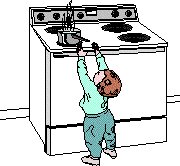Basic Kitchen Safety Tips

Kitchen safety tips is a hugely important topic!
It includes, among other things:
- Child proofing,
- Cleanliness,
- Electrical and grease fires,
- Electrical safety,
- Food safety and preparation,
- Handling hot items (water, hot pans, etc.),
- Handling sharp objects safely,
- Handling small appliances safely,
- Scalding and well . . . you get the picture.
A part of good kitchen organization is planning and preparing for kitchen safety. This page will provide general basic safety information. I hope these kitchen safety tips will be useful.

Basic
Kitchen Safety Tips
- Make sure all wires, cords and plugs on your appliances are not frayed and that the plugs have 3-prong grounded connections. This would include coffee makers, toasters, blenders, microwaves, mixers, etc.
- Don’t use extension cords. You can obtain a junction box that has built-in GFI (ground fault interrupters). This will allow you extra plug-in space and the GFI will kick in if there is a power shortage. Helps avoid water/electrical shock accidents.
- Get rid of any appliance that is broken or damaged. New ones are very inexpensive these days. If a new one would bust your budget, try garage and tag sales (just make sure you’re not buying somebody else’s broken appliance).







Handling Knives
- Always cut away from your body when using a knife. It can slip and cut you,
- Always use a cutting board,
- Protect your counter tops,
- (d) Keep blades sharp,
- Keep knives clean (including handle). Slippery handles can cause injuries,
- Don’t put knives in a sink of soapy water as they may not be seen and accidents can occur,
- Wash and dry carefully keeping sharp edge away from your hands,
- Always lay them flat, never on the back or edge,
- Don’t attempt to catch a knife as it falls; better it hits the floor than cut your hand,
- Wash knives with warm soapy water after each use.
I hope these kitchen safety tips were helpful.
Links to Other Information
Kitchens
Go to: Cooking & Measurements Equivalents
Go to: Kitchen Cleaning
Go to: Kitchen Countertops
Go to: Kitchen Appliance Storage Ideas
Go to: Kitchen Drawer Organizer
Go to: Kitchen Safety Tips
Go to: Kitchen Tips
Go to: Organizing a Kitchen
Go to: Pots & Pans Storage
Links to Other Information
Food Safety, Storage &
Preservation
You might also want to check out the information on these pages:
- Freezer Storage Chart
- Freezer Storage Guidelines
- Dairy Storage Guidelines
- Meat/Fish/Poultry Storage Guidelines
- Kitchen Safety Tips
- Pantry Storage Guidelines
- Picking Produce
- Produce Storage Guidelines
- Refrigerator Storage Guidelines
Click the lavender bar on the left and subscribe to the RSS feed to be notified of new listings as they become available.
Did you like this? Please share it! Thanks in advance.
No matter where you are in life (stay-at-home mom, full or part time employee, retired, etc.) you can make a good income with a website. Whether you write books, make crafts or something else, I highly recommend SBI. It's the reason for this website. Check it out below and become another solopreneur!
Hello! This is Shelly Morton, the author of this website. I know you hear a lot of hype about making money from home and building a successful website. I speak from experience as a solopreneur, I have succeeded with Solo Build It! There is simply no better way to build an online business. Nothing else compares. It's not a "get rich quick" scheme. SBI provides you with all the tools and tips you need to be successful. You put in the work and SBI will help you succeed! SBI is simply the BEST way to get started for any "solopreneur."
(Return to Top of Page..Kitchen Safety Tips)




